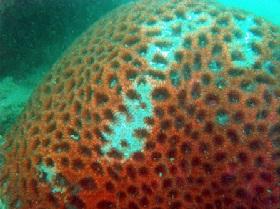Using AI to control energy for indoor agriculture
30 September 2024
Published online 12 March 2014

A living coral complex has adapted to an environment previously thought of as inhospitable to tropical reefs, because of sediment, oil pollution and high seawater temperatures.
Researchers from TU Bergakademie Freiberg, Germany, and the University of Basrah, published their findings this month in Scientific Reports, after the coral reef was discovered during joint explorations by divers from their respective marine science units.
Broder Merkel, vice-rector for research of TU Bergakademie Freiberg and head of the institute's Scientific Diving Center, says: "The discovery is important, in particular for Iraq, because mainstream science believed that, under such environmental conditions, a tropical coral reef could not grow or survive. It shows that the biodiversity of Iraqi waters is greater than was assumed".
Corals are widely distributed throughout the Persian Gulf but had not been found off Iraq's narrow section of coastline. The country's 58km stretch of the Persian Gulf is predominantly a swampy delta formed by the confluence of the Tigris, Euphrates and Karun Rivers, which come together upstream as the Shatt al-Arab, the main outflow source into the gulf.
Ali Douabul, head of the Delta Research Group and of the Department of Marine Environmental Chemistry at the University of Basrah's Marine Science Center, says the Persian Gulf is considered the hottest sea on Earth. Seawater of between 14 and 34°C regularly exceed the temperature tolerance of most corals, generally accepted to be between 18 and 28°C.
Merkel said that not much is yet known about the reef, but that the research team speculates there is more than just the one reef in Iraqi waters.
In the future, participation of scientists from other countries would be appreciated.
Extensive coral reef complexes are not usually found in water with acutely high nutrient loads or suspended sediment concentrations, the study's authors say.
The high nutrient load from discharge of the Shatt al-Arab which results in poor visibility off the Iraqi coast – often limited to a metre or less – had prevented satellite observations from identifying coral reefs in the area.
The relatively healthy reefs cover an area of 28 km2 at depths of 7 to 20 metres and Douabul notes this was significant as deeper reefs may be less vulnerable to movement from tidal currents, which are fairly strong in the region.
The study reports a number of living stone corals were identified from the Iraq coral reef; including the little-known Ophiuroidea, which include basket stars, brittle stars and serpent stars.
Sponges (Porifera) and bivalves which may either compete with corals for space or bio-erode the coral structure were also observed on the reef. Sponges are hyper-sensitive to suspended sediment and are rarely found in such conditions.
Douabul says Iraq's coastal waters face numerous threats, including the impact of oil and gas extraction, coastal development with inadequate marine engineering, unsustainable fishing, poor waste management and the deterioration of water quality.
He says that protecting the coral reefs could substantially increase yields for Iraqi fisherman, as 49% of domestic fish species rely on reefs, but have had to depend on reefs further afield.
The study authors suggest evaluating the health of the Iraqi coral reefs could be a valuable biomarker as the effects of climate change become more pronounced.
"Much more intensive underwater research is needed. At the time being, two Iraqi-German research campaigns are planned. But in the future, participation of scientists from other countries would be appreciated," says Merkel.
doi:10.1038/nmiddleeast.2014.62
Stay connected: